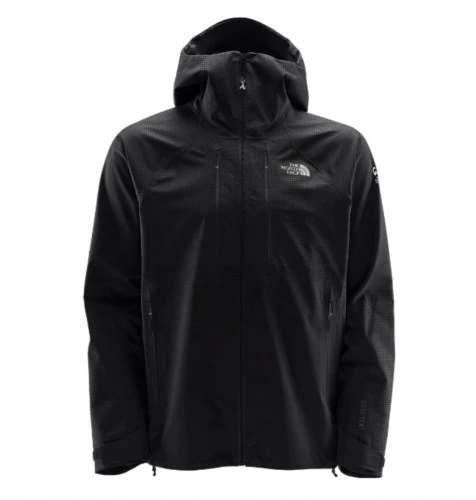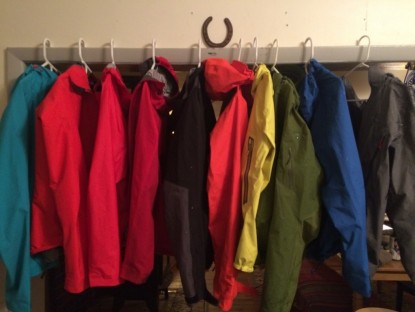The North Face Summit L5 FuseForm GTX Review
Our Verdict
Our Analysis and Test Results
The North Face Summit L5 FuseForm GTX is one of some new hardshells that form the outer layer (L5) of The North Face's integrated layering Summit Series. It is the most expensive and by far the burliest of the collection, combining a standard three-layer Gore-Tex membrane with a very impressive 90D Cordura face fabric. The ridiculously heavy face fabric defines this jacket and should place it squarely at the top of the wish list for alpinists that depend on the durability of their outerwear and are planning to attempt difficult objectives in cold places.
Month-long big walls on Baffin Island or multi-day non-stop vision quests in the Himalayas or Ruth Gorge seem like a perfect fit for this beast of a jacket (although we didn't field test ours on the Moose's Tooth, for full disclosure). Combined with the incredibly durable fabric and construction is a design that does a better job than any other at sealing out the weather, centered around the deep and protective hood that we couldn't even manage to force water into while testing. That said, these qualities also come with some notable drawbacks, such as being heavy, bulky, and the hottest hardshell we tested. Regardless, we felt this jacket was more than worthy of a Top Pick Award for Extreme Weather Protection and Durability. The lighter, more versatile version of this jacket is the Summit L5 GTX Pro, which takes home our Editors' Choice award.
Despite being worthy of recognition as a Top Pick, the Summit L5 FuseForm GTX was not one of the highest scorers in this year's review. To see how it stacked up to the competition, check out the chart above.
Weather Protection
When it comes to keeping the storm on the outside, there is no doubt that this jacket is a perfect choice. We rated it a perfect 10 because we could find no faults with how well it sealed up to keep wind and water out.
We found the hem and the sleeves to be plenty long enough, although they weren't quite as long as the those found on say, the Outdoor Research Interstellar. We also found the hood to be of absolutely exceptional design.
It was super deep so as to provide more than enough coverage both with and without a helmet on, and the brim and collar worked to perfectly overlap on the sides in a way that made it nearly impossible for water to hit one in the face during our downpour testing. Likewise, the DWR coating applied to the outside was pretty much perfect, causing water to bead up and run off without a hint of absorption. This was a very impressive showing.
Weight
For this review, we tested a men's size medium and found that it weighed 1 lb. 5.1 ounces on our independent scale.
While it was about an ounce lighter than the Mountain Hardwear CloudSeeker with the included powder skirt, we gave it the same low score because compared to these two, the next heaviest jacket, the Rab Firewall was over four ounces lighter. That said, this still isn't a prohibitive weight, but the burly face fabric also meant that it wasn't very packable. Put it this way, this isn't a jacket we would want to carry around with us, and we would only consider bringing it if conditions were so gnarly or cold that it warranted wearing it all day long.
Mobility and Fit
Our head tester is 6'0" tall and weighs around 160 lbs. He has broader shoulders but is pretty darn skinny in the torso. On the recommendation of The North Face's website, we purchased a men's size medium for testing, and it fit quite well. The sleeves were long enough, even when swung overhead when climbing, but felt boxy and not well articulated, like the sleeves found on the Arc'teryx Beta AR. The collar was slightly tight against our neck and chin when not wearing the hood, but this complaint was minor.
When it comes to mobility, we felt that the exceedingly heavy fabric caused us to feel like there was a bit of resistance to our movements. There were no actual constricting points in the shape or design of the jacket, just a feeling of heaviness.
Venting and Breathability
This jacket uses a standard Gore-Tex three-layer membrane, but paired with the 90D Cordura, it felt quite hot. On our stationary bike breathability test, we felt like this may have been the single hottest and sweatiest jacket we tested, and we feel like this may have had as much to do with the heaviness of its fabric as the performance of the membrane.
For ventilation, this jacket has dual pit zips that stretch from midway up the side of the torso to halfway down the upper arm. It has four external pockets, but none of them are mesh lined, and it does not have a two-way front zipper.
In terms of ventilation features, this jacket is on par with the Arc'teryx Beta AR. Unlike what we felt about the OR Interstellar, we would not want to buy or wear this jacket for high exertion uphill activities, or even warm climates in general. Its heavy thickness made it feel very warm, and we think it is ideally suited for cold alpine missions where working up a sweat is unlikely to be an issue.
Features
While The North Face Summit L5 FuseForm GTX's feature set could be described as somewhat standard, we felt that all aspects performed excellently, leading us to give it a solid 8 out of 10 points.
It has two external handwarmer pockets that sit a bit low, under the waist belt of a pack. It also has two cross-over chest pockets, one of which has a mesh partition inside for easy storage of a phone. In general, the watertight zippers were easy to pull open and closed. Similar to the design of the Patagonia Pluma and Arc'teryx Alpha FL, this jacket uses only Cohaesive cord locks, employing three of them for adjustment of the hood, and another two to lock down the hem drawcords.
However, in the case of the hem they leave the cord loops pointed down where they can dangle, and in the case of the hood, the pull cords are found deep inside the collar, where they are not easy to access and fine-tune when needed. For these reasons, we gave this jacket a slightly lower score than those other two, which used the same top quality buckles but in a somewhat easier to use design.
Best Applications
The Summit L5 FuseForm GTX is designed as an alpine climbing jacket, and that is where we think it will thrive. In particular, alpine climbs where durability, warmth, and weather protection are necessary, such as rock, mixed, or big walls in remote, cold places. It would also work fine as an ice climbing jacket, or even as a lift-skiing jacket, but due to its heaviness, warmth, and lack of breathability have a bit less cross-over into aerobic activities or summertime backpacking use.
Value
This jacket retails for $650, making it the most expensive one in this review. It uses top of the line materials and high-quality construction to provide superior durability and longevity. For the core user who needs the best of the best, we think this will provide good value. However, for the average user, there are more versatile hardshells at more affordable price points.
Conclusion
The North Face Summit L5 FuseForm GTX takes an opposite approach to hardshell design, eschewing the super lightweight trend to provide bombproof protection. While it has a limited range of use due to its intensely thick, heavy, and hot design, it is ideally designed for the gnarliest of alpine climbing missions in the world's great ranges. Because of this, we are happy to award it our Top Pick for Extreme Weather Protection and Durability.















